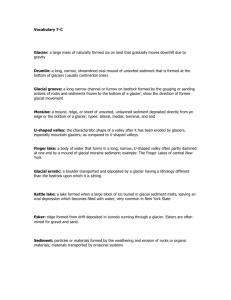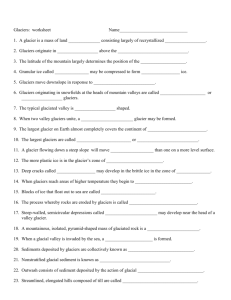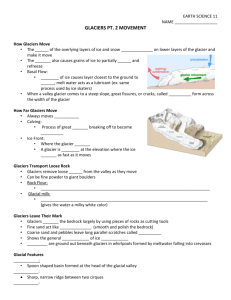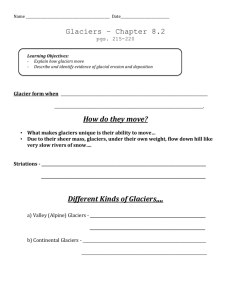Your Name ______ Date ______ Chapter 17 Earth Science Word
advertisement
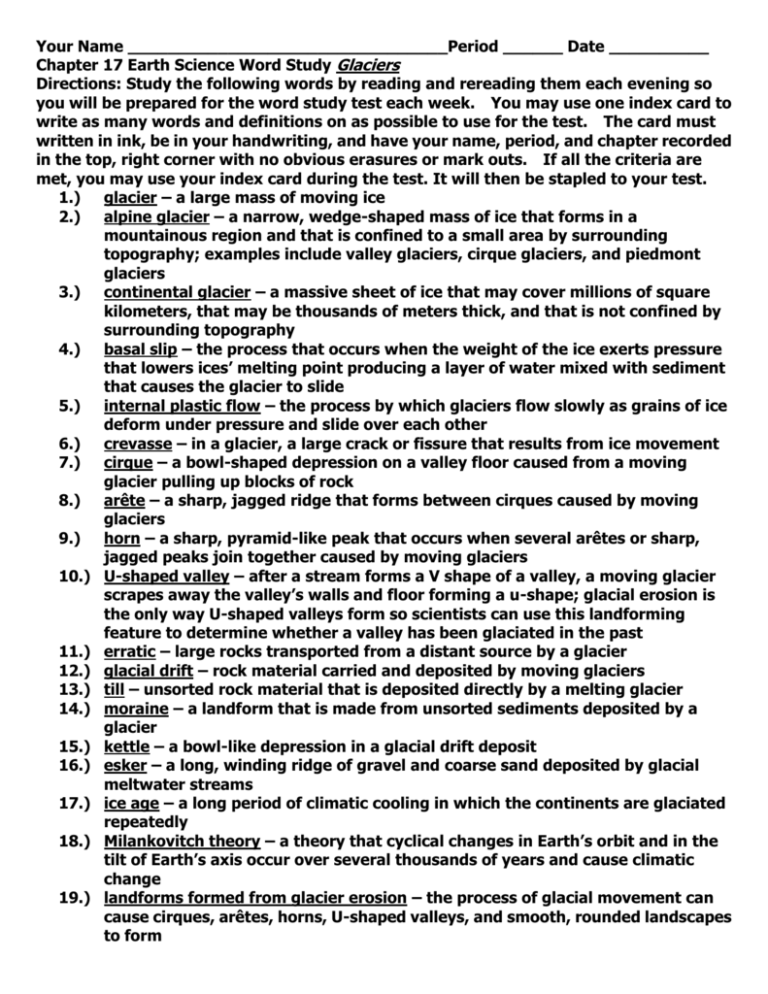
Your Name ________________________________Period ______ Date __________ Chapter 17 Earth Science Word Study Glaciers Directions: Study the following words by reading and rereading them each evening so you will be prepared for the word study test each week. You may use one index card to write as many words and definitions on as possible to use for the test. The card must written in ink, be in your handwriting, and have your name, period, and chapter recorded in the top, right corner with no obvious erasures or mark outs. If all the criteria are met, you may use your index card during the test. It will then be stapled to your test. 1.) glacier – a large mass of moving ice 2.) alpine glacier – a narrow, wedge-shaped mass of ice that forms in a mountainous region and that is confined to a small area by surrounding topography; examples include valley glaciers, cirque glaciers, and piedmont glaciers 3.) continental glacier – a massive sheet of ice that may cover millions of square kilometers, that may be thousands of meters thick, and that is not confined by surrounding topography 4.) basal slip – the process that occurs when the weight of the ice exerts pressure that lowers ices’ melting point producing a layer of water mixed with sediment that causes the glacier to slide 5.) internal plastic flow – the process by which glaciers flow slowly as grains of ice deform under pressure and slide over each other 6.) crevasse – in a glacier, a large crack or fissure that results from ice movement 7.) cirque – a bowl-shaped depression on a valley floor caused from a moving glacier pulling up blocks of rock 8.) arête – a sharp, jagged ridge that forms between cirques caused by moving glaciers 9.) horn – a sharp, pyramid-like peak that occurs when several arêtes or sharp, jagged peaks join together caused by moving glaciers 10.) U-shaped valley – after a stream forms a V shape of a valley, a moving glacier scrapes away the valley’s walls and floor forming a u-shape; glacial erosion is the only way U-shaped valleys form so scientists can use this landforming feature to determine whether a valley has been glaciated in the past 11.) erratic – large rocks transported from a distant source by a glacier 12.) glacial drift – rock material carried and deposited by moving glaciers 13.) till – unsorted rock material that is deposited directly by a melting glacier 14.) moraine – a landform that is made from unsorted sediments deposited by a glacier 15.) kettle – a bowl-like depression in a glacial drift deposit 16.) esker – a long, winding ridge of gravel and coarse sand deposited by glacial meltwater streams 17.) ice age – a long period of climatic cooling in which the continents are glaciated repeatedly 18.) Milankovitch theory – a theory that cyclical changes in Earth’s orbit and in the tilt of Earth’s axis occur over several thousands of years and cause climatic change 19.) landforms formed from glacier erosion – the process of glacial movement can cause cirques, arêtes, horns, U-shaped valleys, and smooth, rounded landscapes to form


